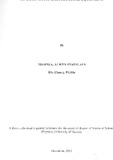| dc.description.abstract | Kenya has about 3,000 X-ray and 30 Computed Tomography (CT) units. Most of these units
(80%) are not calibrated. The remainder are calibrated by use of transfer standards whose
calibration status is unknown, hence a broken international traceability chain. Many hospitals
and clinics use different radiation qualities and standards, some of which may be unsuitable
due to non-calibration after many years of use or replacement of major parts. Where
calibrations were actually performed, the test equipment are either not calibrated or
sometimes sent out of the country for the service at a considerable cost. For this reason, there
is need to establish this capability in the country to bridge this gap.
The objective of the study was to develop reference X-ray radiation beam qualities (RQR) at
the Secondary Standards Dosimetry Laboratory (SSDL), KEBS ..RQR represent the beam that
,:':.1,1
is incident on a patient when undetg~.Jhg diagnostic medical examinations and provides
diagnostic dosimetry traceability that is presently lacking in Kenya.
Air kerma rates were determined using a one litre reference free in air ionization chamber
calibrated at the Primary Standards Dosimetry Laboratory at PTB in Germany. By
determination of the Half Value Layers (I:IVL), narrow series beam qualities meeting the ISO
4037 part 1 criteria were established using high purity aluminium filters placed in the beam.
Various RQR were then established using a 30 crrr' Xradin A4 chamber to determine air
kerma, HVL and homogeneity coefficient for each beam quality setting.
The results obtained comp~red to the IEC 61267criteria and were evaluated by use of
statistical mean and percentage standard deviations..of the measurands, interpolation, ICRP
developed formulae and conversion factors taking i~to account the effect of temperature and
pressure to obtain the corrected values of charge produced in ionization chambers.
iv
Compared to the ISO 4037 criteria, the interpolated HVL values were found to be in
agreement within the ± 5 % tolerance. The developed reference radiation beams were found
to be within the ±3% allowable limits. RQR beam parameters were adjusted by addition of
filtration and tested to comply with the IEC 61627 standard criteria. Sources of measurement
uncertainties (resolution, calibration, position from tube focus and standard deviation) were
identified and estimated. The main source of uncertainty (0.58 %) during the calibration
process was found to be due to the ionization chamber positioning set-up.
The established narrow series (N-series) were found to comply with the ISO 4037
requirements within ± 4 %. Subsequent RQR beam parameters established were found to be
in agreement with the standard values in IEC 61267 within ± 1 %, within the permissible
tolerance limits of ± 3 % for both the homogeneity coefficient .§lndfirst HVL. All reference
radiations were reproduced with succ~/ithin the lEe tolerance limits. Therefore the SSDL
at KEBS can calibrate transfer standards and provide an unbroken chain oftraceability. | en |

